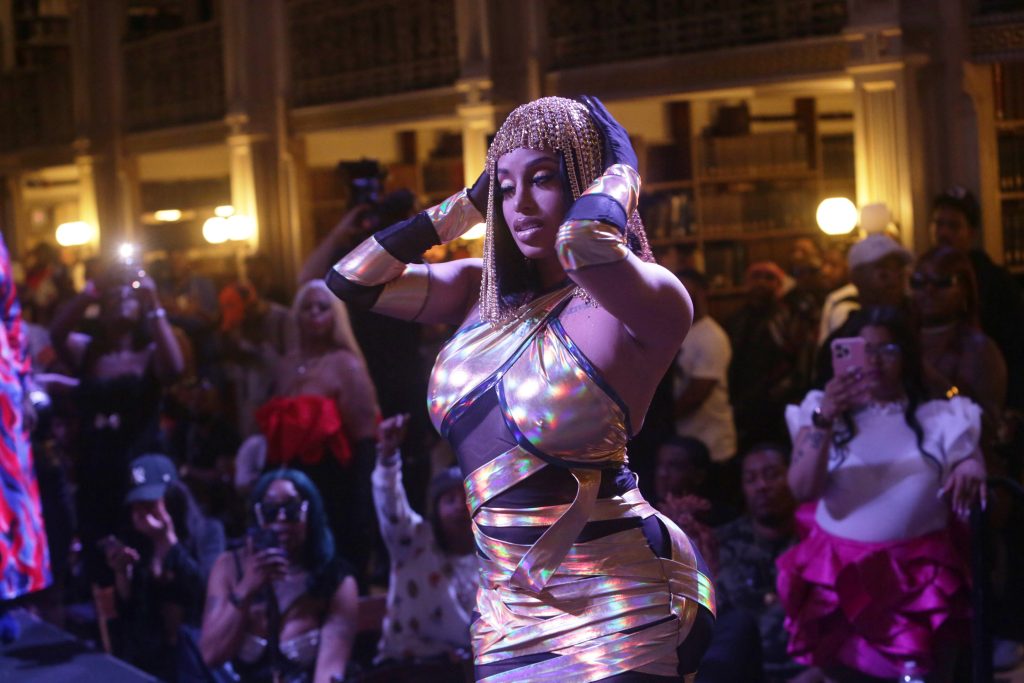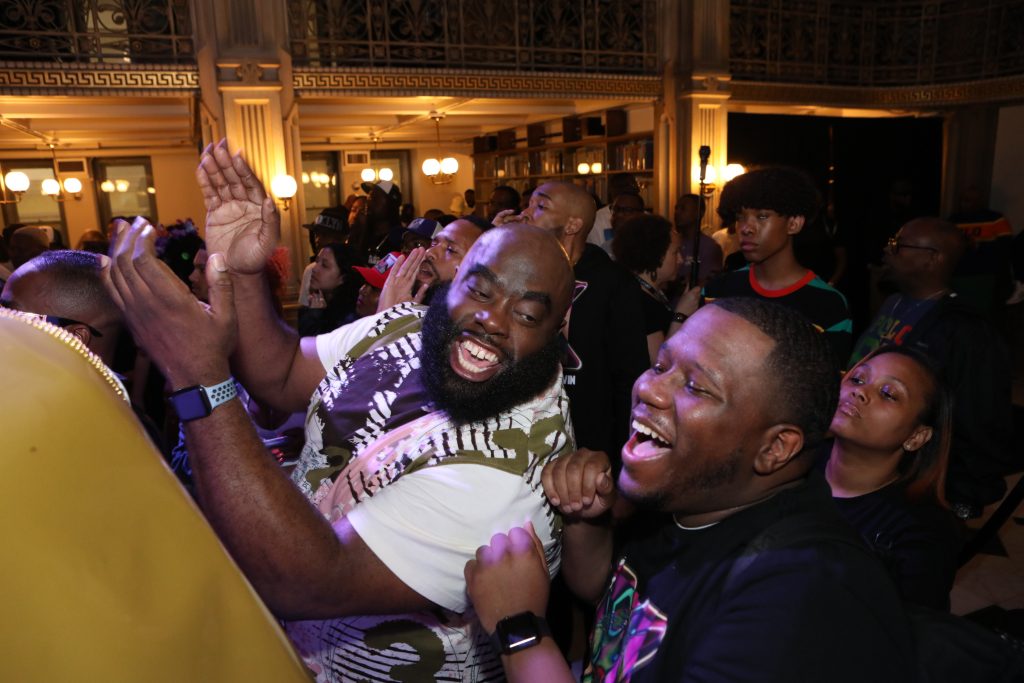The ballroom scene is a nearly century-old performance-based culture composed primarily of queer, lesbian, trans, and gender non-conforming artists of color. Recently popularized by the television show Pose, ballroom consists of chosen families, or houses, and the opulent ball competitions they produce. Ball competitions are more than spectacles of creativity and fabulousness: they are rituals that call forth and renew black LGBTQ cultural traditions. The electronic music derives from modern progressions of the African drum and is influenced by blues, jazz, gospel, and funk. Voguing, an improvised dance form, derives from a variety of black diasporic movement practices and the performance practices of trans women. The gender-bending costumes stem from the extravagant drag balls staged in U.S. cities as early as the 1890s. Ball commentators, or masters of ceremony, are griots: storytellers and living archives of the community’s cultural knowledge. In short, the ballroom scene mobilizes performance as a system of learning, storing, and transmitting history and knowledge.
History and performance collided on Saturday, April 15, 2023, when hundreds of ballroom artists and guests gathered for the Winston Tabb Special Collection Research Center’s third ball competition at the opulent George Peabody Library. Titled “Baltimore Beautiful Symbols,” the ball honored “the trailblazers and blueprints – the ‘royalty’ – who paved the way for Baltimore’s ballroom scene.” For months leading up to the event, I collaborated with four ballroom leaders—Legendary Rhonda Carr, Icon Enrique St. Laurent, Legendary Marco West, and Icon Sebastian Escada—to curate more than a dozen competition categories that showcased Baltimore’s ballroom history while also drawing inspiration from the Sheridan Libraries’ historic collections. The Peabody Library itself—with its soaring atrium, tiers of cast-iron balconies and black-and-white marble floor—was a fitting backdrop for an eye-popping history lesson about Baltimore’s ballroom scene.
At the ball, performers embodied the Legends and Icons who paved the way for those gathered in the Library. For example, trans performers competed for prizes in a category Rhonda Carr titled “Cleopatra” in honor of Baltimore ballroom legend Sabrina Icon, “a queen much like Cleopatra.” In instructions circulated before the ball, Carr asked performers to “compel the judges” by “embodying” Cleopatra and Sabrina Icon. As they competed, vintage YouTube videos of Sabrina Icon’s past performances played on a screen behind the runway and the event commentators recounted her contributions to the scene. Another category, written by Enrique St. Laurent, required dancers to perform in the style of vogue legend Ricky Allure, embodying his “grace, antics and clever stunts.” They dressed “as a mystical fairy,” inspired by the Peabody Library’s copy of Michael Drayton’s Nymphidia: the Court of Fairy (1814).
Among the guests invited to the ball were Hopkins students enrolled in my course “Queer Performativity” (Spring 2023). My students studied ballroom history for three weeks and attended a class session co-taught by my collaborator Legendary Marco West. Learning about ballroom history and culture enabled students to attend the ball as knowledgeable participants, rather than voyeurs, and to appreciate performance as a system of learning, storing, and transmitting knowledge.
Below are reflections written by students who attended the ball:
Sam Godinez:
I had the privilege of attending the Peabody Ballroom Experience as a student in Dr. Joseph Plaster’s course Queer Performativity. The George Peabody Library, consistently ranked among the most beautiful libraries in the world, was remarkably upstaged by ballroom artists’ vibrant performances. The talent and creativity of the performers were unbelievably impressive; each runway category prompted performers to bring life to rare books from the Johns Hopkins University Sheridan Libraries, a great challenge that was surpassed with each step made on the stage. It was an amazing opportunity to both supplement my learning and have fun.
Our readings in Dr. Plaster’s class were brought to life; everything I read in Madison Moore’s Fabulous (Yale University Press, 2018) was exemplified with each performance: performers on stage exuded a fierceness that drew everyone watching into another world. The music, makeup, and dancing transformed the Library into a stadium filled with joy and confidence. Every performance showcased the potential to create community and connection through art.
As I watched the performers pay homage to Baltimore’s legends and icons of the ballroom scene, I was struck by the importance of preserving cultural history. It’s important to remember that it is not a privilege for the ballroom community to be hosted at Johns Hopkins, but rather an honor for Johns Hopkins University to be entrusted with documenting the Baltimore Ballroom community’s history and legacy. This event is a testament to the resilience and creativity of Baltimore’s ballroom community; I feel grateful to have been a part of this unforgettable event and to have witnessed the beauty of Baltimore’s ballroom scene firsthand.
Annie Nguyen:
As a student in Dr. Plaster’s undergraduate class, Queer Performativity, I got the valuable opportunity to be able to participate in the ball despite not being a member of the ballroom community myself. The experience I had at the ball put all the things I’ve learned in class about the history of ball and its transformative power for the queer community into perspective. We learned about Black queer history and the development of ballroom culture for three weeks before we attended the ball. Being able to see, listen, feel, and immerse myself in the performances that I had read about in class readings and only saw in YouTube videos prior to the ball helped shape my understanding of the beauty of ball culture, of people’s passion for it, and the work that goes into the development of queer of color worldmaking.
As Dr. Plaster recalled in his essay “The Category Is… Opulence!”, many ballroom members told him that commentators are the soul of the competitions. They narrate and control balls all over the cities, states, countries, and anywhere ball culture is presented. Commentators remember past balls, their categories, and who won what, and would encourage performers to re-enact or be inspired by a past performance, paying homage to the people that had come before and paved the way for the current ballroom culture.
This was especially clear in the ball that I attended, which intended to honor “trailblazers and blueprints – the ‘royalty’ – who paved the way for Baltimore’s ballroom scene.” In this ball, each category was designed to honor one or a few past Icons. Every time a category began, the screen on the stage would switch to videos of the icons’ performances and the commentators would either tell stories about them or recount their most memorable performances, and always commemorated the contributions that they had given to the Baltimore ballroom community, making sure that the audience and all those who were presented in the ball become a part of the network that preserve the history.
Jordan Holleran:
History was the word of the day this past Saturday at the Peabody Ball. From the categories to the costumes to the books that lined the many floors of the space, every moment of it was referential, putting modern and creative takes on historical events and fashion, evoking everything from the “Blood of our Ancestors” to “Cleopatra.” More than that, there is a deep past to ballroom that was also on display. For over an hour, the event paid homage to the many Legends and Icons that paved the way for the people in that room. Categories were dedicated to big-name performers in the scene, a constant reminder of the figures that came before and made a mark on this community. The ball did not feel like a simple, one night event. It was part of a legacy of the many balls and performers that have taken stage in nights just like this.
Yet, while the past was put on stage, this event was very much about the present. From the moment I stepped inside the doors and into the library, it was like walking into another world, a world of opulence, a world of glamor. I spent most of the night standing in the crowd surrounded by members of various houses. The excitement and drama of each moment was something that I became a part of, hearing everyone’s reactions, praise, and criticism. In front of all of us, for a few fleeting moments, everyone that stepped foot on stage was a star. They strutted and vogued as if they were the only person worth paying attention to, living in the now and creating a few minutes where all eyes were on them – and I couldn’t look away.
Helen Hu:
With its broad pillared exterior, the Peabody Library stood solemnly amongst the silent evening of the cobbled streets of Mount Vernon. However, upon entering its doors, I was instantly enveloped in a change in atmosphere – bright lights illuminated a crowd of tall, striking, fashionably dressed people mingling joyously in spirited conversation and hugs. Performance was blurred between the audience and the catwalk, making the whole space ethereal. The shining highlight of the night, however, was unmistakably the visuals. Ruffles of finely detailed fabric sparkled on the runway on bodies just as glimmering and stylish. Yet, as madison moore writes in Fabulous, the allure of the show was more than just the clothing itself, but rather “the sensuality, the opulence, and of course the attitude” (page 171) of the performers.
Behind every expressive garment was an even more expressive competitor bringing the outfit to life. Though there is no doubt that the Peabody Ball is intimidatingly well-executed in everything from the cutting-edge designs to graceful gaits, no sense of judgement or pretention radiated from a single person in the ballroom. The event, in every way, gushed with a sense of affection and kinship. Heartfelt speeches and the presentation of awards to dedicated ballroom figures reminded attendees of the true purpose of the ball in connecting the community behind it. The Peabody Ballroom Experience is a warm celebration of the rich culture and talents of Baltimore’s ballroom scene, as grand and historic as the library that hosts it.
The Peabody Ballroom Experience’s epic ball competitions are just one component of a public humanities project that cultivates an exchange of knowledge between Johns Hopkins University and ballroom. More information about the project is available at our multimedia website.



